As you may surmise from previous articles I have contributed to MasonicFind, I very much enjoy the history between The Church of Jesus Christ of Latter-day Saints and Freemasonry.
Since the time that I became a Mason in 2016, this has become one of my favorite areas of study. A lot of rumors surround this relationship, including the history of the Lodges in and about Nauvoo, Illinois.
What happened to those Lodges?
They eventually lost their dispensations (or charter, in one Lodge’s case), and three of them were declared clandestine by the Grand Lodge AF&AM of Illinois.
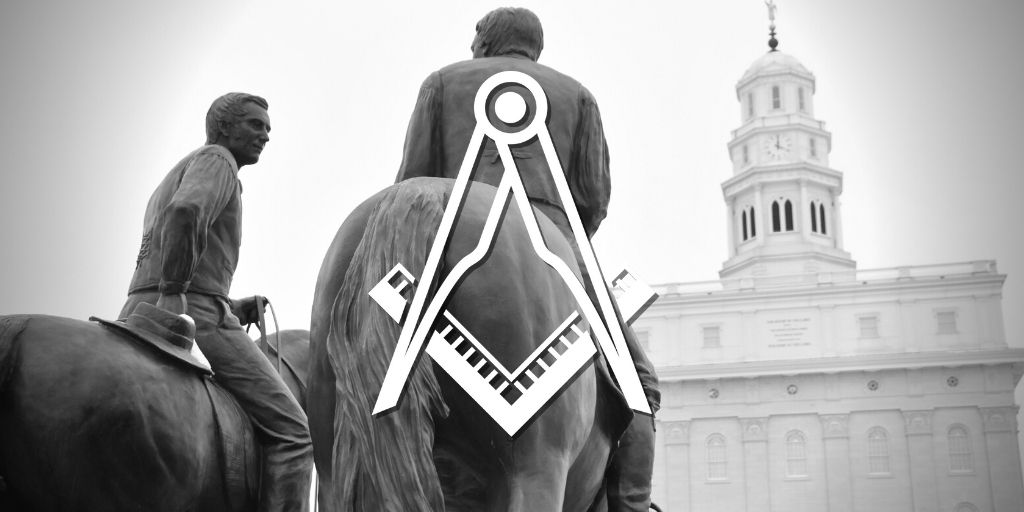
Prior to Nauvoo
The Church of Jesus Christ of Latter-day Saints (often incorrectly referenced as “The Mormon Church”) had previously been legally established in Fayette, New York on 6 April 1830.
Religious persecution (which would be a recurring theme of the Latter-day Saint experience throughout the 19th century) led them to migrate to various places throughout what then constituted the United States; in some places during this time, the Church also expanded quite a bit.
For a comprehensive history, the reader is referred to the Church’s Saints series.
Arrival to Nauvoo
Members and the headquarters of the Church relocated to Nauvoo (previously called Commerce) in 1839.
Joseph named the place Nauvoo because it is a Hebrew term meaning “beautiful.” I imagine that the early members of the Church thought this to be a result of heat stroke or some other malady because at the time it was nothing more than a mosquito-infested swamp. However, their years there turned the place into a beautiful little town.
Petition to Charter a Lodge
Some had already been Freemasons for years before they had joined the Church, including:
- Hyrum Smith (the Patriarch of the Church; an older sibling of Joseph Smith Jr, who was the President of the Church)
- Heber C. Kimball
- Newel K. Whitney
- John C. Bennett
- Lucius N. Scovil
- Noah Rodgers
- James Adams
Joseph Smith Sr (father to the president of the Church) is also believed to have previously been a Mason, but evidence for this is scant.
In 1841, some of these (and other) Masons sent a petition to the Grand Lodge of the Ancient Free and Accepted Masons of Illinois for a charter for a Lodge in Nauvoo.
The Grand Master Abraham Jonas (the first Grand Master of this Grand Lodge, which had just been established in 1840 after a thirteen-year absence of a Grand Lodge in the state) issued a dispensation (like a temporary charter) in the summer of 1841 that allowed these Masons to meet, though more as a club than a Lodge; however, they were not permitted to confer degrees upon or initiate any new members until a new dispensation was issued later that year (15 October), making them an actual Lodge.
In this new dispensation (which empowered this Lodge to meet and work as Masons until the annual communication/session/conference of the Grand Lodge of Illinois in October 1842), Grand Master Jonas appointed the following as the presiding officers for “Nauvoo Lodge, U.D.” (“Under Dispensation”):
- Worshipful Master: George Miller
- Senior Warden: John D. Parker
- Junior Warden: Lucius N. Scovil
At their first meeting as a Lodge on 29 December 1841, they accepted this dispensation and elected for the following offices the following people:
- Secretary: John C. Bennett
- Treasurer: Newell K. Whitney
- Senior Deacon: Charles Allen
- Junior Deacon: Heber C. Kimball
- Stewards: William Felshaw
Hiram Clark
- Tyler: Samuel Rolfe
Hyrum Smith was often elected to serve as Junior Warden in a pro-tempore capacity during this time. Bennett, Kimball, and Miller were appointed to serve on a committee to draft and report a code of by-laws for the Lodge, which were accepted, instituted, and signed the next day.
On 3 January 1842, it was suggested at the Lodge’s meeting that they hold off on installing their officers so that Grand Master Jonas could attend; a resolution passed to send the Grand Master an invitation to their Installation.
Installation of Officers and Initiation of the Prophet
On 15 March 1842 at 9:00 AM, the Lodge opened for a special meeting for the purpose of installing its officers. Grand Master Jonas was in attendance and presided over the meeting; W. D. McCann, Deputy Grand Secretary, was also in attendance.
Everyone gathered into Joseph Smith’s office above his Red Brick Store (where Lodge meetings would often be held until the Masonic Hall was built).

Jonas opened not only Nauvoo Lodge, U.D. but also the Grand Lodge of Illinois for this event.
He then organized the plans for installation, then called the Lodge and Grand Lodge to recess until 1:00 PM, at which time John C. Bennett (who was serving in a pro-tempore capacity as the Grand Marshall for this occasion) was directed to form a procession and ordered to lead it to a nearby grove of trees for the installation ceremony.
Joseph Smith Jr. (who was not yet a Freemason), as allowed by the Constitution of the Grand Lodge, served in a pro-tempore capacity as the Grand Chaplain for this event.
After the ceremonies of installation were completed, Grand Master Jonas gave a “highly creditable and finished address on the subject of Ancient York Masonry” (Craft Masonry was often referenced at that period as “York Masonry”), after which the Lodge and Grand Lodge returned to the Lodge room where they were duly adjourned.
At 7:00 PM, the Lodge opened again, this time for the purpose of initiating Joseph Smith Jr and Sidney Rigdon as Entered Apprentices. Grand Master Jonas presented a special dispensation in the case of Joseph and Sidney, authorizing the Lodge “to receive the petitions of Joseph Smith, and Sidney Rigdon — and act on the same instanter — and should the ballot be unanimous in favor of said Smith and Rigdon at a full meeting of said Nauvoo Lodge — then in that case — the said Lodge is authorized to confer the three several degrees of Ancient York Masonry on the said Joseph Smith and Sidney Rigdon — as speedily as the nature of the case will admit […]”
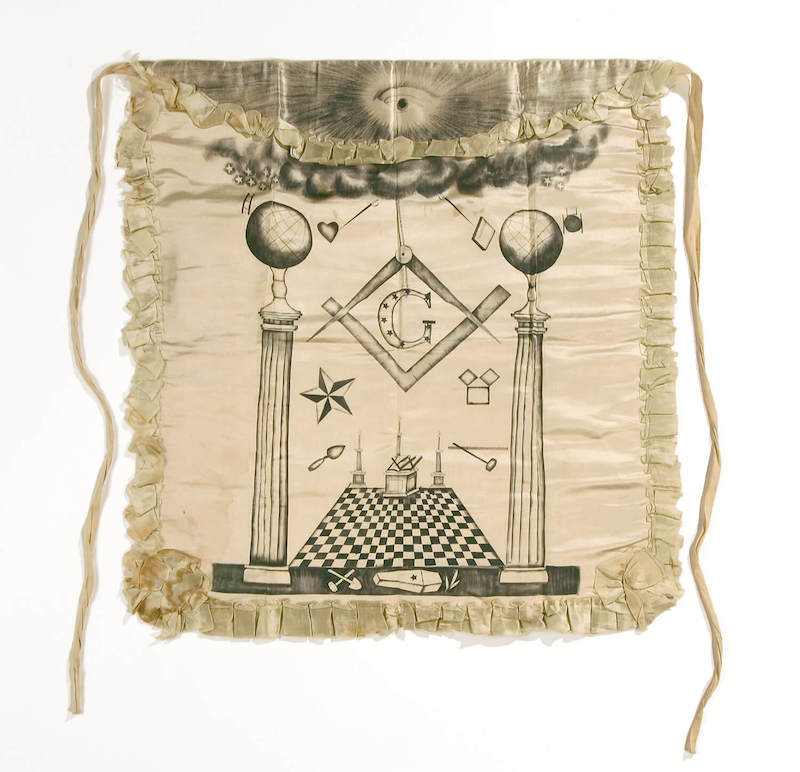
In other words, Joseph and Sidney could go through all three degrees within a short timespan (the equivalent of a Grand Master’s class today).
Joseph and Sidney’s petitions were then presented to the Lodge, where they were balloted upon separately and elected unanimously to be candidates for the Entered Apprentice Degree. They were then each duly initiated.
At 9:00 AM the next morning, they each applied to be passed to the degree of Fellowcraft.
Their proficiency in the Entered Apprentice degree “was vouched for,” after which they were balloted for, which unanimously elected them as candidates for the Fellowcraft degree.
They were both duly raised thereto, after which the Lodge was called to recess.
At 2:00 PM, Joseph applied to be raised to the degree of Master Mason, was unanimously elected by ballot, and was duly raised, after which the Lodge was called to recess. At 7:00 PM, the same happened for Sidney. Grand Master Jonas presided at each of these degree ceremonies.
Rising Sun Lodge
Sometime after this, another Lodge of Latter-day Saints was established under dispensation by Grand Master Jonas: Rising Sun Lodge U.D., located in Montrose, Iowa Territory (since the Iowa, which would become a state later in 1846, did not yet have its own Grand Lodge; Montrose is located just across the Mississippi River from Nauvoo).
Irregular Work and Exponential Growth
The dispensation that Grand Master Jonas had written for Joseph and for Sidney was specific only to them; it did not apply to other petitioners or candidates.
However, it appears that Nauvoo Lodge operated from then on as if such were the standard procedure allowed by the regulations of the Grand Lodge.
They started to put people through the degrees rather quickly, as had been allowed specifically for Joseph and Sidney. Provided below is a table with five examples of such speedy progress being allowed to others.
| Name | Initiated an EA | Passed to FC | Raised to MM |
| Brigham Young | 7 April 1842 | 8 April 1842 | 9 April 1842 |
| John Taylor | 21 April 1842 | 29 April 1842 | 30 April 1842 |
| Wilford Woodruff | 26 April 1842 | 28 April 1842 | 29 April 1842 |
| Amasa Lyman | 8 April 1842 | 11 April 1842 | 12 April 1842 |
| Theodore Turley | 8 April 1842 | 11 April 1842 | 19 April 1842 |
| D. B. Huntington | 11 April 1842 | 13 April 1842 | 14 April 1842 |
These are just a small handful. Because of this irregularity, the membership of the Lodge started to grow rather quickly, to the point where the Masons of Nauvoo Lodge soon easily outnumbered the rest of the Masons in Illinois.
Suspension and Reinstatement of Nauvoo Lodge’s Dispensation
Other Lodges nearby Nauvoo started to notice the rapid growth of membership. Masons at Bodley Lodge No. 1 (located in Quincy, Illinois) issued several charges against Nauvoo Lodge, claiming that their work was “irregular” (or illegitimate).
This led to Nauvoo Lodge’s dispensation being suspended on 11 August 1842, starting at which time the Masons in Nauvoo were prohibited to cease meeting/working as a Lodge, which prohibition they obeyed.
These irregularities and this suspension were then reported at the Grand Lodge’s Annual Communication on 4 October of that year.
A committee that had been appointed to address these issues offered the resolutions that 1) this suspension continue for a year and 2) a special committee be appointed to examine the original minutes of Nauvoo Lodge to investigate the claims of irregularities and to report them at the next year’s annual communication.
Past Grand Master Jonas (whose successor, Meredith Helm, had already been installed as the Grand Master at this time) offered a substitute to these resolutions: that a special committee be appointed and sent immediately to Nauvoo to look into any irregularities/misconduct, examine the persons and papers connected to these issues, and report everything back to the Grand Master; and that the Grand Master then make a decision whether to continue the suspension or to reinstate the dispensation of Nauvoo Lodge without having to wait until the next Annual Communication. This substitute resolution passed.
This committee, composed of Jonathan Nye (Past Grand Master of the Grand Lodge of Virginia; future Grand Master of the Grand Encampment of Knights Templar, USA) and W. B. Warren, who reported to the Grand Master that they found the principal charges of irregularity “groundless.” They did find minor irregularities, which were:
- Balloting on more than one applicant/petitioner at a time.
- Receiving an applicant/petitioner of dubious character on the promise of reformation and restitution.
The committee recommended 1) a course of mercy and allowance for Nauvoo Lodge to continue meeting and working as Masons and 2) that the Grand Lodge appoint someone to attend Nauvoo Lodge for some given time to make sure that they avoid any such irregularities.
Grand Master Helm then ordered the reinstatement of Nauvoo Lodge’s dispensation and that they be empowered and authorized to meet and work as a Lodge. Nauvoo Lodge started meeting again on 10 November of that year.
Due to a large number of Masons in Nauvoo, two other Lodges were later formed in 1843 under dispensation: Nye Lodge, U.D. and Helm Lodge, U.D.
Keokuk Lodge
Sometime between October 1842 and October 1843, a Lodge of Latter-day Saints was established under dispensation in Keokuk, Iowa Territory (located about 9 miles south of Montrose, where Rising Sun Lodge was located).
Continued Irregularities, Exponential Growth, and Revocation of Dispensation
Unfortunately, Nauvoo Lodge did not learn its lesson; it continued to initiate, pass, and raise large sums of people in small timeframes.
Eventually, the number of Masons in Nauvoo exceeded 1,500 (and, at that time, made up about half of the Masonic population of the United States of America).
Grand Master Helm therefore again sent someone to Nauvoo Lodge in 1843, this time to collect and suspend their dispensation again.
However, it was reported later in the Annual Communication that this Grand Lodge representative was met “with contempt” and that the members of Nauvoo Lodge refused to relinquish their dispensation.
However, Nauvoo Lodge’s minutes indicate that the Grand Lodge did not make a proper request for the dispensation.
It was reported there that Nauvoo Lodge had also failed to bring their Lodge records to this Annual Communication for inspection (which is generally required for any Lodge).
Just in case Nauvoo Lodge would be granted a charter (which they had requested and were hoping to get at this 1843 Annual Communication), Grand Master Helm suggested that it be split into four or more distinct Lodges due to its size, which ultimately rendered it inefficient in the progress and overall Masonic experience of the individual Masons (with which assessment Nauvoo Lodge agreed).
However, due to the lack of respect shown by Nauvoo Lodge to the Grand Lodge, a resolution passed on 4 October at that Communication to revoke Nauvoo Lodge’s dispensation, to deny its request for a charter, and to suspend its membership from the benefits of Masonry.
Other Lodges Affected at the 1843 Annual Communication
Keokuk Lodge, U.D. was found to be doing irregular work “in that in as many as six instances, petitions have been presented and acted on in a shorter period than one lunar month […],” the minimum amount of time then required in Illinois between the presenting of a petition and the Lodge balloting on it.
The work of Rising Sun Lodge No. 12 was deemed irregular and their dues were reported not to have been paid to the Grand Lodge.
It was resolved that this Lodge’s charter be suspended and that the Master and Wardens of this Lodge be cited to appear at the next year’s Communication to demonstrate why their charter should not be revoked.
Helm Lodge, U.D. was found to be doing irregular work; specifically, “in receiving and acting on four petitions in one day; and improvident in passing and raising to the Third Degree, oftentimes within two days after initiation […]” They also had not paid their dues to the Grand Lodge. It was also reported that Helm Lodge refused to present their records of work to the Grand Lodge.
Nye Lodge, U.D. was found to be doing similarly irregular work as Helm Lodge; particularly, “[in] receiving four petitions on one day, and initiating on the next, in as many as six instances.
And also in pushing the candidate through the second and third Degree before he can possibly be skilled in the preceding degree.”
On the same date as for Nauvoo Lodge, resolutions were passed to revoke dispensations of and refuse charters for Helm, Nye, and Keokuk Lodges.
Nauvoo’s Disregard of Suspension and Dedication of Masonic Hall
On 2 November 1843, Nauvoo Lodge held a meeting to discuss and vote concerning whether they should heed the suspension and quit meeting as a Lodge.
The result of the vote was that the Lodge would continue to meet and work as Masons. Hyrum Smith (who was now the Worshipful Master of the Lodge and had been since Grand Master Helm had previously restored the Lodge’s dispensation in 1842) spoke about how the Grand Lodge had done injury to the character of the members of Nauvoo Lodge and suggested that they would appeal the issue to a higher authority: the Grand Lodge of the United States.
This might have been a fine idea, except for the fact that no such organization has ever existed (not in recognized, regular Masonry, anyway). The Lodge next voted to continue working on building the Masonic Hall that they had already started to plan.
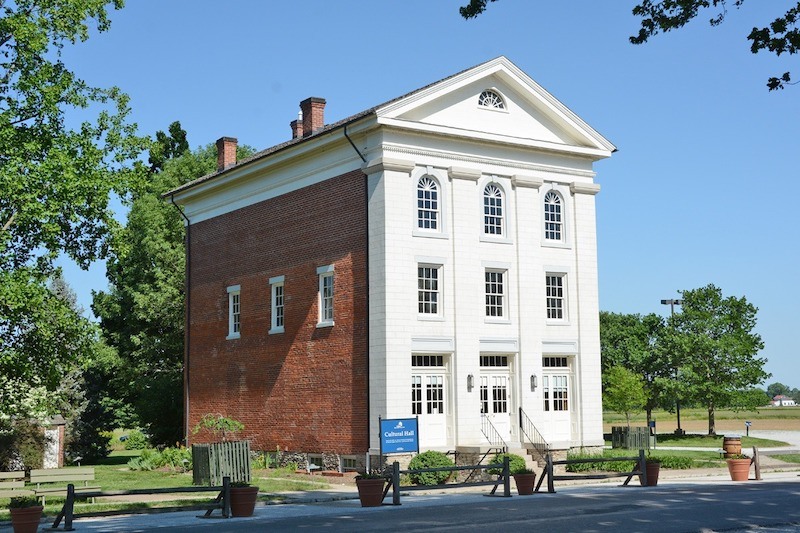
The Masonic Hall in Nauvoo was completed prior to and dedicated on 5 April 1844.
Hundreds of people were in attendance (which is not all that surprising, given that Nauvoo Lodge’s own membership consisted of 1,500 men).

Members of Nauvoo Lodge, dressed in their suits and aprons, led a parade down Main Street to the Lodge. From all accounts, it was a neat spectacle to behold.
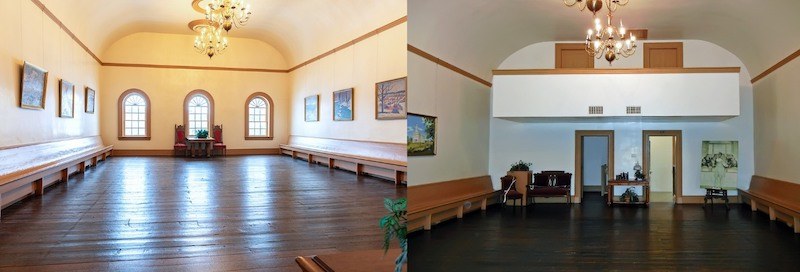
A special Lodge meeting was held for the event as well, in which both Dr. William Goforth (Marshal of St. Clair Lodge No. 4; the following October, he was expelled from Illinois Masonry for having attended this dedication) and Joseph Smith Jr gave inspiring, educational lectures.
Nauvoo Lodge continued to grow thereafter.
Assassinations of the Prophet and Patriarch
On 7 June 1844, the Nauvoo Expositor, a newspaper antagonistic to the Church, came out with its first and only publication, which criticized Joseph Smith for teaching principles concerning plural marriage and exaltation.
The City Council of Nauvoo (about half of which was composed of Latter-day Saints) ordered the destruction of the Expositor, deeming it a public nuisance according to the city charter (freedom of the press, although protected from federal government infringement, was not yet protected from state or local government infringement, nor would it be until the 14th Amendment to the Bill of Rights was ratified).
As mayor, Joseph Smith was duty-bound to see the Council’s orders duly executed; he summoned the City Marshall and had the Marshall destroy the Expositor.
Reports of mobs gathering to attack Nauvoo as vengeance for the destruction of the Expositor began to pour in.
On 18 June 1844, in his capacities as Mayor of Nauvoo and Lieutenant General of the Nauvoo Legion (a militia chartered by the Governor of Illinois that consisted of about 5,000 men), Joseph declared martial law on the city and stationed the Nauvoo Legion to protect it. He ordered Nauvoo’s entrenchment as a prepared defense.
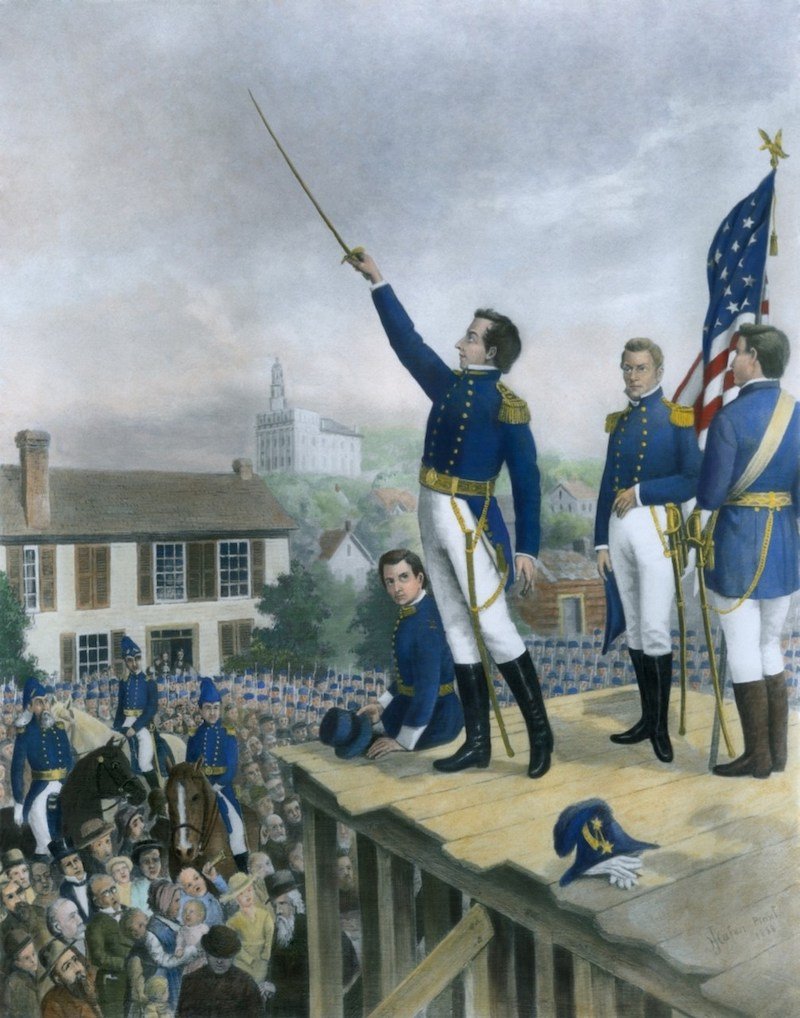
People started to call for Joseph’s arrest, and on 25 June he surrendered himself and was arrested in order to plead his case concerning charges of riot (for passing on the order to destroy the Expositor) and charges of treason (for declaring martial law without cause); however, he remarked the entire time that he was only going to be butchered, “like a lamb to the slaughter.”
Joseph and his brother Hyrum (who had also been arrested) were taken to Carthage, Illinois; a few other members of the Church accompanied their group, including fellow Nauvoo Lodge members Willard Richards, John Taylor, and Joseph Bates Noble.
During the trek, Joseph Smith gifted his Nauvoo Legion sabre to Noble and ordered Noble to go back to Nauvoo, to which order Noble complied, albeit with dismay. That sabre remained in Noble’s family up until it was donated to the Church in 2009.
On 27 June, a mob (disguised in blackface) stormed the jail in Carthage where Joseph, Hyrum, John Taylor, and Willard Richards were incarcerated.
A friend had smuggled a pepperbox pistol the day before, with which Joseph was now armed. John and Willard were armed with canes in case the mob got through the door.
Hyrum was shot first, exclaiming “I am a dead man!” as he fell to the floor; he took a ball to his back and another to his face. Joseph was hit with a ball shot from the other side of the door.
He ended up falling out of the second-story window. His last words were, “O Lord, my God.” He was propped up against the well, after which a firing squad of five men killed him.
John Taylor and Willard Richards, though wounded, survived.
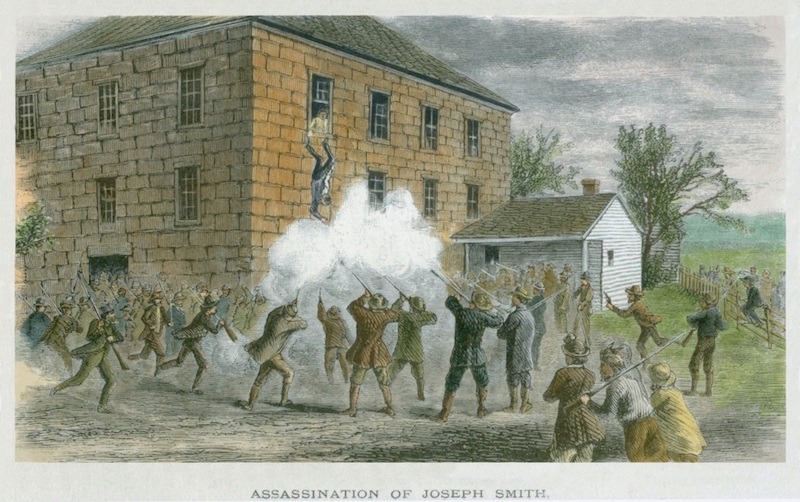
Taylor (who would later serve as the third President of the Church) was under the belief that there were Masons present in the mob; however, this was never proven in a court of law. The five men who had been indicted for participating in the mob of approximately 200 men were cleared of all charges.
Joseph had been a candidate for President of the United States at this time and was the first US Presidential candidate ever to have been assassinated.
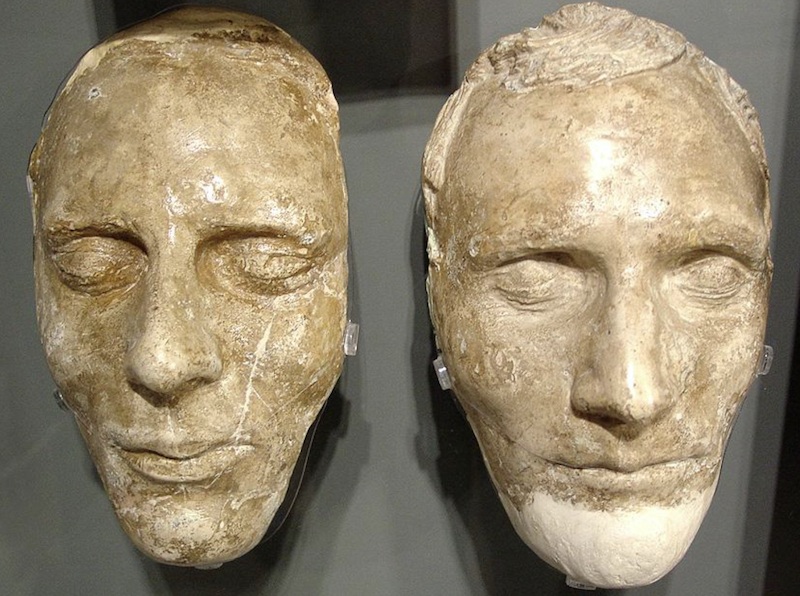
Keokuk Uninformed and Unanswered
On 24 September 1844, the members of Keokuk Lodge wrote a lengthy letter to the Grand Lodge, essentially demanding an explanation for the Grand Lodge’s disposition to their Latter-day Saint brethren. “We have written twice to the Grand Secretary and received no answer,” they claimed.
Apparently, both the Grand Lodge of Illinois and Keokuk’s representative (S. N. Scovil) at the 1843 Annual Communication failed to inform Keokuk Lodge that they had been suspended, as they later had to learn about this from outside sources, at which point they stopped meeting and working as Masons.
Grand Lodge’s Declaration of Nauvoo’s Clandestine Status
On 10 October 1844, it was reported that Nauvoo Lodge would continue to operate, even without the consent of the Grand Lodge of Illinois. A resolution was therefore adopted concerning Nauvoo, Helm, and Nye Lodges:
“that all fellowship with said Lodges, and the members thereof, be withdrawn, and the Association of Masons working these Lodges are hereby declared clandestine; and all the members hailing therefrom, suspended from all the privileges of Masonry within the jurisdiction of this Grand Lodge; and that our sister Grand Lodges be requested to deny them the same privileges.”
The End of the Clandestine Lodges
On 10 April 1845, Brigham Young (then the President of the Church) and George A. Smith (an apostle of the Church) “advised Lucius N. Scovil, keeper of the lodge, to suspend the work of that institution in consequence of the information furnished us by Dr. Goforth, of hostile actions on the part of the Grand Lodge of Illinois against the lodge at Nauvoo.”
Warsaw Lodge No. 21 in Hot Water
At the October 1845 Annual Communication of the Grand Lodge of Illinois, Warsaw Lodge was reprimanded for having initiated, passed, and raised three of the five men who had been indicted (but not yet cleared) of charges of conspiracy to commit the murders of Joseph and Hyrum, which event caused an investigation into the matter.
On 22 March 1846, the committee assigned to carry out this investigation confirmed that those three men had, indeed, been initiated, passed, and raised in Warsaw Lodge while being indicted of crimes and without having been cleared of those indictments.
However, by the time of this Masonic investigation in 1846, those three men had already been cleared of those charges. This committee therefore suggested that Grand Master W. F. Walker extend mercy on the Lodge, which he did.
However, Warsaw Lodge ended up closing down and relinquishing their charter in 1847, supposedly for the reason that their meeting space was too small (though that had not been an issue, apparently, since 1843 when the Lodge was formed).
Exodus West and Failure to Charter New Lodge
The Saints were again forced to flee their homes due to religious persecution. In September 1846, they started to leave Nauvoo for what is now Salt Lake City, Utah (a 1,300-mile trek).
After arriving in what is now Utah (which was then a part of Mexico), some of the former members of Nauvoo Lodge attempted to gain a charter for a new Lodge in their new home.
They sent petitions for charters to one of the various Grand Lodges of Mexico and another to the United Grand Lodge of England.
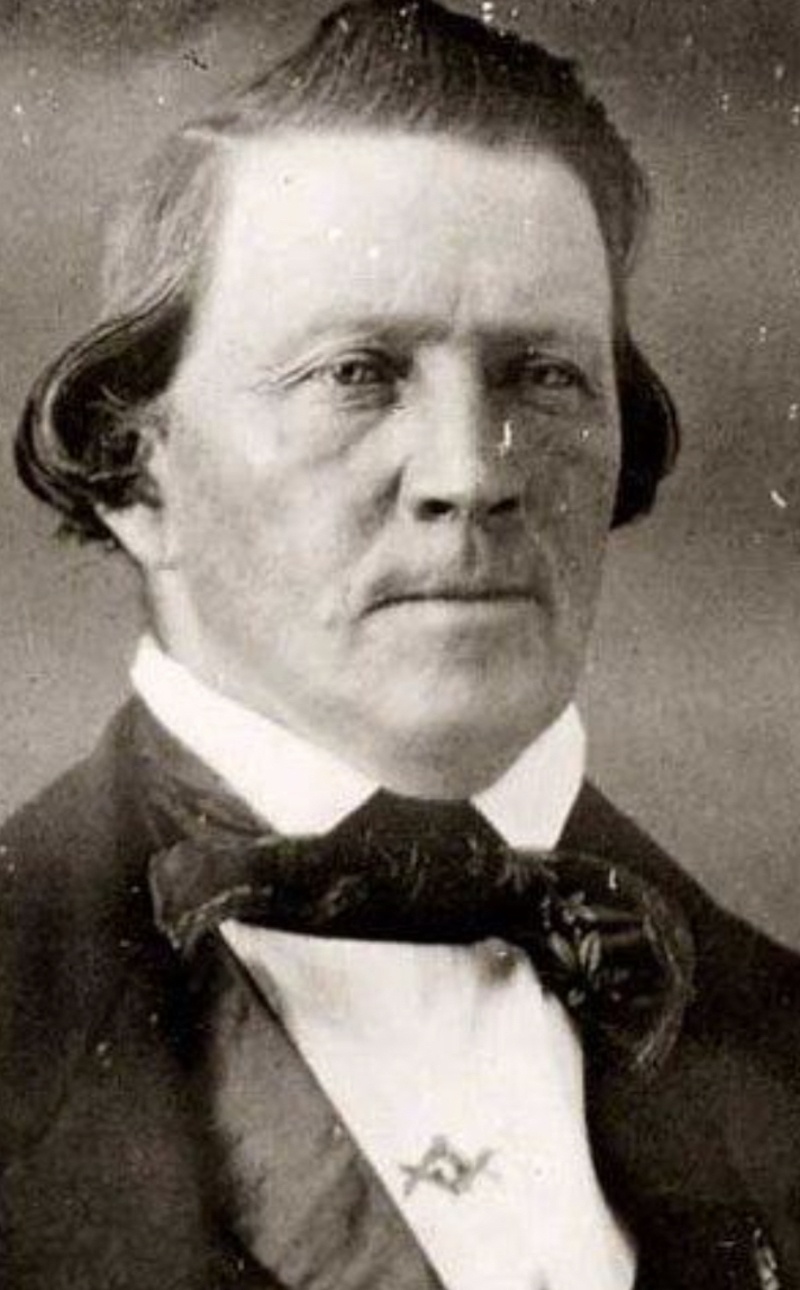
Their request to Mexico was refused and there is no record of their request to England ever having arrived at its destined address.
After these failed attempts, Brigham Young then advised these men to drop the matter; these men who had endured the exodus West and remained in what is now Utah never joined any other Masonic Lodges during their respective lifetimes.
Exception Made for some Nauvoo Masons
At the October 1846 Annual Communication, a resolution was adopted that the suspension of a subordinate Lodge in Illinois would only affect the individual standing of a member insofar as they participated in disregarding the edicts of the Grand Lodge, and insofar as such edicts had come to their knowledge.
This was passed because at least one member of Nye Lodge (who had been away on business at the time that its dispensation was revoked) was never informed that Nye Lodge was suspended and that his individual standing with the Grand Lodge was therefore impaired and was therefore refused entry into one of the subordinate Lodges of the Grand Lodge of Kentucky.
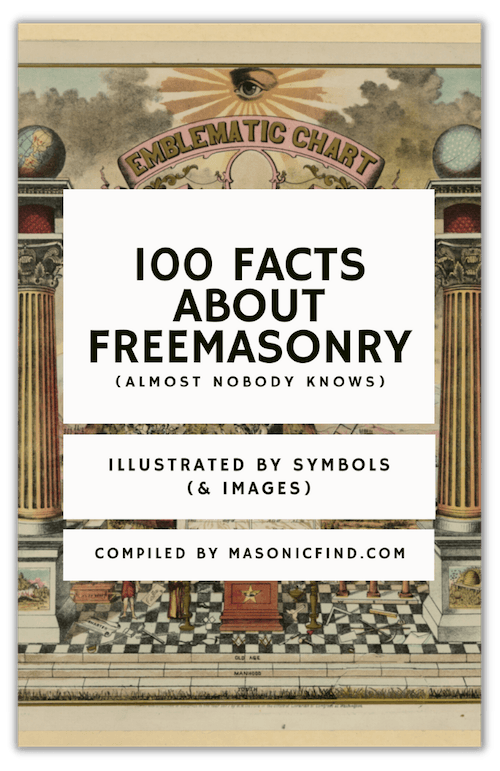
FREE DOWNLOAD: 100 FACTS ABOUT FREEMASONRY (ALMOST NOBODY KNOWS)
Join the 10,000+ Brethren from around the world inside our weekly Masonic newsletter and get our best selling ebook for free (usual value: $20).
Conclusion
Today, a jurisdiction’s Grand Secretary may issue certificates of good standing to individual Masons once a Lodge is permanently shut down; they are considered unaffiliated Masons until they join another Lodge.
However, it appears that this was not the protocol back in the 1840s (as I recently learned).
Most of the Masons in and about Nauvoo were unfortunately suspended and three of their Lodges were deemed clandestine by the Grand Lodge of Illinois.
It seems that most Lodges outside of these five discouraged any intervisitation with the “Mormon Lodges”; which could very well have been a huge factor in these Lodges not doing their local Masonic work within the regulations of the Grand Lodge.
After all, these were new Lodges composed mostly of new Masons; and the relatively few Masons who were not new to Masonry were still new to Illinoian regulations (having become Masons under different Grand Lodges).
This stated, this says nothing about these five Lodges failing 1) to implement any corrections provided by the Grand Lodge of Illinois, 2) to provide their annual records to the Grand Lodge for inspection, and 3) to pay all of their dues to the Grand Lodge. The same can be said for the other four Lodges as applicable.
Joseph Jr and Hyrum Smith, through no fault of their own, were under suspension at the time of their deaths; however, they were not clandestine Masons, as the decree of clandestine status occurred months after they were killed.
As for Joseph, there is the slimmest chance that he could have been granted a status of good standing had he survived Carthage and lived to see October 1847; he is not recorded as having been present at the November 1843 meeting where the Lodge was informed that the Grand Lodge had ordered Nauvoo Lodge to cease meeting and working as Masons.
There is therefore the tiniest possibility that he was never informed, especially with his busy schedule as Mayor of Nauvoo, Lieutenant-General of the Nauvoo Legion, President of the Church, teacher at the School of the Prophets, overseer of the construction of the Church’s temple, candidate for the office of President of the United States, merchant/owner of his Red Brick Store, and so on.
This combined with the resolution that a Lodge’s suspension does not affect the individual’s standing if that individual does not knowingly disregard the edicts of the Grand Lodge, therefore, allows Joseph the smallest, slimmest possibility of obtaining individual reinstatement to a status of good standing.
Is it probable? No. Is it possible? Absolutely.
This article was written for MasonicFind.com by WM Brandon Cole.